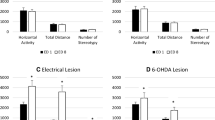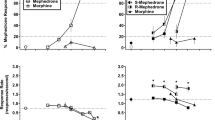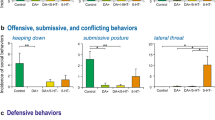Abstract
This experiment examined the effect of destroying the 5-hydroxytryptaminergic (5HTergic) pathways on the acquisition and performance of discrimination between two brief time intervals. Rats that had received injections of 5,7-dihydroxytryptamine into the dorsal and median raphe nuclei, and sham-lesioned control rats were trained in a series of discrete trials to press lever A following a 200-ms presentation of a light stimulus and lever B following an 800-ms presentation of the same stimulus. Both groups gradually acquired accurate performance, attaining 80%–85% accuracy by the end of 40 sessions. The lesioned group learnt the task significantly faster than the control group. When stable performance had been attained, “probe” trials were introduced in which the light was presented for intermediate durations. Both groups showed sigmoid functions relating percent choice of lever B to log stimulus duration. The bisection point (duration corresponding to 50% choice of lever B) did not differ significantly between the two groups; however, the Weber fraction was significantly smaller in the lesioned group than in the control group. The levels of 5HT and 5-hydroxy-indole-acetic acid were markedly reduced in the brains of the lesioned rats, but the levels of noradrenaline and dopamine were not altered. The results indicate that destruction of the 5HTergic pathways facilitates acquisition of a temporal discrimination. The lack of an effect of the lesion on the bisection point contrasts with our previous finding using longer stimulus durations; it is suggested that different behavioural processes may underlie millisecond-range and second-range temporal discrimination, and that these may be differently affected by 5HT depletion.
Similar content being viewed by others
References
Altman HG, Normile HJ (1988) What is the nature of the role of the serotonergic nervous system in learning and memory: prospects for development of an effective treatment strategy for senile dementia. Neurobiol Aging 9:627–638
Altman HG, Normile HJ, Galloway MP, Ramirez A, Azmitia EC (1990) Enhanced spatial discrimination learning in rats following 5,7-DHT-induced serotonergic deafferentation of the hippocampus. Brain Res 518:61–66
Baumgarten HG, Jenner S, Bjorklund A, Klemm HP, Schlossberger HG (1982) Serotonin neurotoxins. In: Osborne NN (ed) Biology of serotonergic transmission. Wiley, Chichester
Chatlosh DL, Wassermann EA (1987) Delayed temporal discrimination in pigeons: a comparison of two procedures. J Exp Anal Behav 47: 299–309
Church RM, Deluty MZ (1977) Bisection of temporal intervals. J Exp Psychol [Anim Behav Proc] 3: 216–228
Deakin JFW (1983) Roles of serotonergic systems in escape, avoidance and other behaviours. In: Cooper SJ (ed) Theory in psychopharmacology, vol 2. Academic Press, New York
Deakin JFW, Graeff FG (1991) 5-HT and mechanisms of defence. J Psychopharmacol 54: 305–315
Fetterman JG, Killeen PR (1992) Time discrimination inColumba livia andHomo sapiens. J Exp Psychol [Anim Behav Proc] 18: 80–94
Fletcher PJ (1993) A comparison of the effects of dorsal or median raphe injections of 8-OH-DPAT in 3 operant tasks measuring response inhibition. Behav Brain Res 54: 187–197
Gibbon J (1977) Scalar expectancy theory and Weber's law in animal timing. Psychol Rev 84: 279–325
Grant DS, Spetch ML (1993) Analogical and nonanalogical coding of samples differing in duration in a choice-matching task in pigeons. J Exp Psychol [Anim Behav Proc] 19: 15–25
Heffner TG, Hartman JA, Seiden LS (1980) A method for the regional dissection of the rat brain. Pharmacol Biochem Behav 13: 453–456
Killeen PR, Fetterman JG (1988) A behavioral theory of timing. Psychol Rev 95: 274–295
Lewis D (1960) Quantitative methods in psychology. Springer, Berlin Heidelberg New York
McEntee WJ, Crook TH (1991) Serotonin, memory, and aging brain. Psychopharmacology 103: 143–149
Morrissey G, Wogar MA, Bradshaw CM, Szabadi E (1993) Effect of lesions of the ascending 5-hydroxytryptaminergic pathways on timing behaviour investigated with an interval bisection task. Psychopharmacology 112: 80–85
Morrissey G, Ho M-Y, Wogar MA, Bradshaw CM, Szabadi E (1994) Effect of lesions of the ascending 5-hydroxy-tryptaminergic pathways on timing behaviour investigated with the fixed-interval peak procedure. Psychopharmacology 114: 463–468
Platt JR, Davis ER (1983) Bisection of temporal intervals by pigeons. J Exp Psychol [Anim Behav Proc] 9: 160–170
Soubrié P (1986) Reconciling the role of central serotonin neurons in human and animal behavior. Behav Brain Sci 9: 319–364
Ward B, Everitt BJ, Robbins TW, Wilkinson LS (1992) The acquisition of a conditional visual discrimination is facilitated by 5,7-dihydroxytryptamine-induced lesions of forebrain serotonergic projections in rats (abstract). J Psychopharmacol 6: 127
Wirtshafter D, Asin KE (1986) Discrimination learning and reversal following electrolytic lesions of the median raphe nucleus. Physiol Behav 37: 213–219
Wogar MA, Bradshaw CM, Szabadi E (1991) Evidence for an involvement of 5-hydroxytryptaminergic neurones in the maintenance of operant behaviour by positive reinforcement. Psychopharmacology 105: 119–124
Wogar MA, Bradshaw CM, Szabadi E (1992) Impaired acquisition of temporal differentiation performance following lesions of the ascending 5-hydroxytryptaminergic pathways. Psychopharmacology 107: 373–378
Wogar MA, Bradshaw CM, Szabadi E (1993) Does the effect of central 5-hydroxytryptamine depletion on timing depend on motivational change? Psychopharmacology 112: 86–92
Author information
Authors and Affiliations
Rights and permissions
About this article
Cite this article
Graham, S., Ho, M.Y., Bradshaw, C.M. et al. Facilitated acquisition of a temporal discrimination following destruction of the ascending 5-hydroxytryptaminergic pathways. Psychopharmacology 116, 373–378 (1994). https://doi.org/10.1007/BF02245343
Received:
Revised:
Issue Date:
DOI: https://doi.org/10.1007/BF02245343




